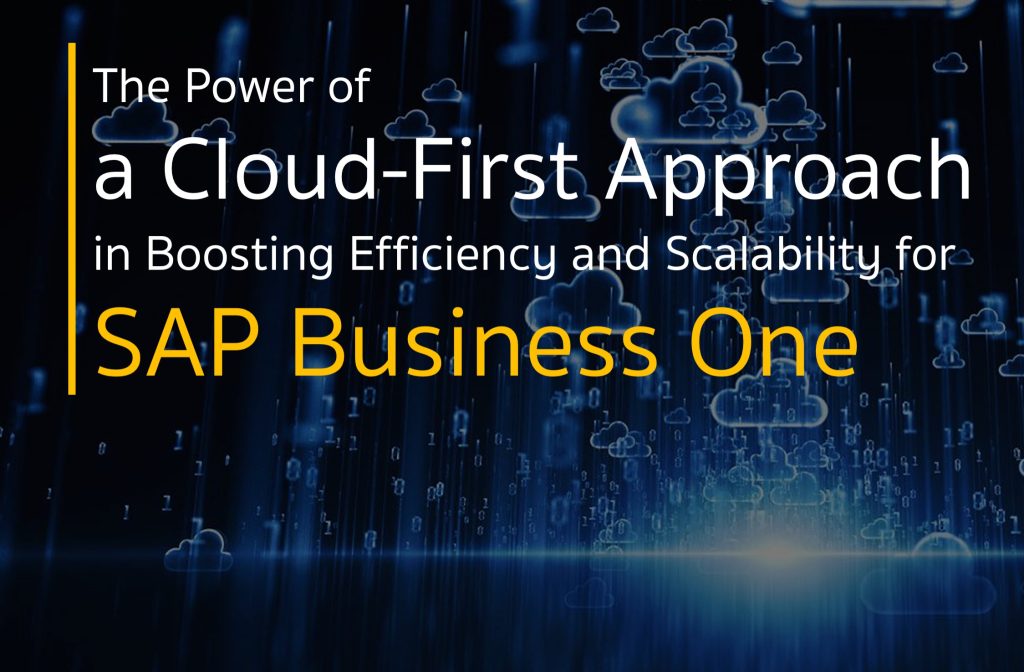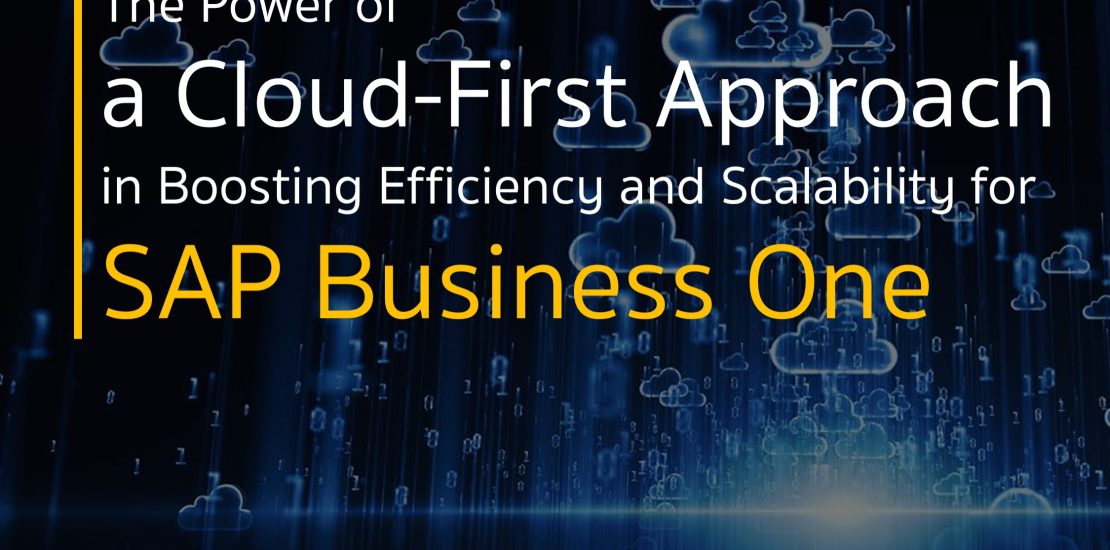The Power of a Cloud-First Approach in Boosting Efficiency and Scalability for SAP Business One

In today’s business landscape, efficiency and scalability are key factors in driving success and growth. And for businesses using SAP Business One, adopting a cloud-first approach can unlock the true potential of this powerful ERP solution. By harnessing the power of the cloud, businesses can enjoy enhanced efficiency, improved scalability, and increased flexibility. This article explores the benefits of a cloud-first approach in optimizing SAP Business One, enabling businesses to streamline operations, access real-time data, and meet evolving customer demands. From reducing IT infrastructure costs to enabling remote access and seamless integrations, the cloud empowers businesses to scale their operations effortlessly while ensuring data security and availability. Join us as we delve into the power and potential of a cloud-first approach to boost efficiency and scalability for SAP Business One, and discover how it can transform your business operations for the better.
Understanding SAP Business One
SAP Business One is an integrated enterprise resource planning (ERP) solution designed specifically for small and medium-sized businesses (SMBs). It provides a comprehensive set of tools and functionalities to manage various aspects of a business, including finance, sales, customer relationship management (CRM), inventory, and production. With its user-friendly interface and customizable features, SAP Business One enables businesses to streamline their operations, improve decision-making, and drive growth.
The benefits of a cloud-first approach for SAP Business One
A cloud-first approach for SAP Business One offers numerous benefits that can significantly enhance efficiency and scalability. One of the key advantages is the ability to reduce IT infrastructure costs. By leveraging cloud-based solutions, businesses no longer need to invest in expensive hardware and infrastructure. Instead, they can rely on a cloud service provider to handle the hardware, maintenance, and upgrades, resulting in cost savings and a more predictable IT budget.
Another benefit of a cloud-first approach is the ability to access real-time data from anywhere, at any time. With SAP Business One deployed in the cloud, businesses can securely access their ERP system through a web browser or mobile app. This enables remote access for employees, allowing them to stay connected and productive even when working from different locations. Real-time data access also facilitates better decision-making by providing up-to-date insights into sales, inventory, and financials.
Additionally, a cloud-first approach enables seamless integrations with other business applications and systems. SAP Business One can easily integrate with third-party software, such as CRM systems, e-commerce platforms, and business intelligence tools. This integration capability eliminates data silos and enables a more connected and efficient workflow. For example, integrating SAP Business One with a CRM system allows sales teams to access customer information and order history directly from the CRM interface, improving sales efficiency and customer satisfaction.
Increasing efficiency with cloud-based solutions
Cloud-based solutions offer several features and functionalities that can significantly enhance efficiency for SAP Business One users. One such feature is automated backups and disaster recovery. With data stored in the cloud, businesses can ensure that their critical information is regularly backed up and protected from unforeseen events such as hardware failures or natural disasters. This eliminates the need for manual backups and reduces the risk of data loss or downtime.
Another efficiency-boosting feature is the ability to scale resources on-demand. With traditional on-premises infrastructure, businesses often need to invest in additional hardware to accommodate peak workloads or seasonal spikes in demand. This can result in underutilized resources during off-peak periods. However, with a cloud-first approach, businesses can easily scale up or down their computing resources based on their current needs. This elasticity allows for optimal resource utilization and cost savings, as businesses only pay for the resources they actually use.
Furthermore, cloud-based solutions provide enhanced collaboration capabilities. With SAP Business One deployed in the cloud, multiple users can access and collaborate on the same data simultaneously. This promotes teamwork, improves productivity, and eliminates the need for manual data synchronization or version control. Collaboration features such as document sharing, real-time editing, and commenting streamline business processes and enable faster decision-making.
Enhancing scalability with a cloud-first approach
Scalability is a critical factor for businesses seeking growth and expansion. With a cloud-first approach, businesses using SAP Business One can easily scale their operations without the limitations of traditional on-premises infrastructure. Cloud-based solutions offer the flexibility to quickly add or remove users, increase storage capacity, and accommodate growing business needs. This scalability ensures that businesses can adapt to changing market conditions, seize new opportunities, and stay ahead of the competition.
In addition to scaling resources, a cloud-first approach also facilitates geographic expansion. With on-premises infrastructure, businesses would need to set up physical servers and IT infrastructure in each new location, resulting in significant costs and logistical challenges. However, with a cloud-first approach, businesses can quickly deploy SAP Business One in new locations by leveraging the infrastructure and data centers of their cloud service provider. This eliminates the need for complex infrastructure setup and reduces the time to market for new branches or subsidiaries.
Furthermore, a cloud-first approach enables businesses to easily integrate acquisitions or merge with other companies. The cloud provides a unified platform where different systems and processes can be seamlessly integrated, allowing for smoother transitions and easier consolidation of operations. This scalability and integration capability make a cloud-first approach ideal for businesses with growth plans or those undergoing mergers and acquisitions.
Key considerations when adopting a cloud-first approach for SAP Business One
While the benefits of a cloud-first approach for SAP Business One are clear, there are several key considerations that businesses should keep in mind when making the transition. One of the primary considerations is data security and privacy. When moving sensitive business data to the cloud, it is crucial to ensure that the chosen cloud service provider has robust security measures in place. This includes encryption, access controls, regular security audits, and compliance with industry regulations such as GDPR or HIPAA.
Another important consideration is the reliability and availability of the cloud service. Businesses should choose a cloud service provider that offers high uptime guarantees and redundant data centers to minimize the risk of service disruptions or data loss. It is also essential to have a backup and disaster recovery plan in place to ensure business continuity in the event of an outage or data breach.
Additionally, businesses should consider the integration capabilities of the cloud service provider. SAP Business One relies on seamless integration with other business applications and systems to maximize its efficiency and effectiveness. Therefore, it is crucial to choose a cloud service provider that supports the necessary integrations and has a track record of successful integrations with SAP Business One.
Case studies: Successful implementation of a cloud-first approach for SAP Business One
To illustrate the benefits and potential of a cloud-first approach for SAP Business One, let’s look at a couple of real-world case studies:
- Company A: A manufacturing company with multiple locations and a growing customer base. By adopting a cloud-first approach, Company A was able to streamline its operations by centralizing its SAP Business One deployment in the cloud. This enabled real-time collaboration between different departments and locations, resulting in improved production efficiency and reduced lead times. The company also leveraged the scalability of the cloud to quickly add new users and accommodate increased demand during peak seasons.
- Company B: An e-commerce retailer experiencing rapid growth and frequent website traffic spikes. By migrating its SAP Business One deployment to the cloud, Company B was able to scale its infrastructure on-demand to handle increased website traffic during promotional campaigns and seasonal sales. This ensured a seamless online shopping experience for customers, reduced the risk of website crashes, and improved overall customer satisfaction. The cloud also enabled seamless integration between SAP Business One and the company’s e-commerce platform, ensuring accurate inventory management and order fulfillment.
These case studies demonstrate how a cloud-first approach can transform businesses by enhancing efficiency, scalability, and customer satisfaction.
Best practices for implementing a cloud-first approach for SAP Business One
To ensure a successful implementation of a cloud-first approach for SAP Business One, businesses should follow these best practices:
- Define clear objectives: Clearly define the goals and objectives of adopting a cloud-first approach. Identify the specific areas where the cloud can bring the most value to your business, such as cost savings, scalability, or improved collaboration.
- Choose the right cloud service provider: Conduct thorough research and choose a reputable cloud service provider that specializes in SAP Business One deployments. Look for providers with a proven track record, strong security measures, high availability guarantees, and integration capabilities.
- Plan the migration process: Develop a detailed migration plan that includes data migration strategies, testing procedures, and a timeline for the transition. Engage with your cloud service provider to ensure a smooth and seamless migration process.
- Train and educate employees: Provide comprehensive training and education to employees to ensure they can leverage the full potential of SAP Business One in the cloud. This includes training on accessing the system remotely, utilizing collaboration features, and understanding the security measures in place.
- Monitor and optimize performance: Regularly monitor the performance of your SAP Business One deployment in the cloud and optimize as needed. Leverage monitoring tools provided by your cloud service provider to identify any bottlenecks, optimize resource utilization, and ensure optimal system performance.
Cloud service providers for SAP Business One
There are several cloud service providers that specialize in hosting SAP Business One deployments. Some of the leading providers include:
- Microsoft Azure: Azure provides a comprehensive set of cloud services and has a strong focus on enterprise-grade security and compliance. They offer seamless integration with SAP systems and provide extensive support for SAP Business One deployments.
- Amazon Web Services (AWS): AWS offers a wide range of cloud services and has extensive experience hosting SAP Business One deployments. Their infrastructure is highly scalable, reliable, and secure, making them a popular choice for businesses of all sizes.
Also, there’re local cloud service providers we would like to recommend.
- iNet Cloud Service: INET Cloud relies on the ideal safety standard via high-speed internet network and MetroLAN that link with the business buildings to continue your business smoothly and connect to the internet quickly and efficiently. INET Cloud utilizes the excellent hardware equipment and is managed by the skillful staff who is qualified with VMware Certificate.
- SYMPHONY Cloud Service: Its cloud service integrates with SYMPHONY Network, delivering reliable and high performance for fast, stable and secured data storage and transaction.
These cloud service providers offer the necessary infrastructure, security, and support to ensure a successful cloud-first approach for SAP Business One.
Conclusion: Embracing the power of a cloud-first approach for SAP Business One
In conclusion, adopting a cloud-first approach can unlock the true potential of SAP Business One, enabling businesses to boost efficiency and scalability. By leveraging the power of the cloud, businesses can reduce IT infrastructure costs, access real-time data, and seamlessly integrate with other business applications. The cloud also provides enhanced collaboration capabilities, automated backups, and disaster recovery, ensuring data security and availability. However, businesses should carefully consider factors such as data security, reliability, and integration capabilities when choosing a cloud service provider. By following best practices and leveraging the expertise of reputable cloud service providers, businesses can successfully implement a cloud-first approach for SAP Business One and transform their operations for the better. Embrace the power of the cloud, and unlock the true potential of SAP Business One today.
More information about SAP Business One, please contact:
Sundae Solutions Co., Ltd.
T| +6626348899 E| sales@sundae.co.th
W| https://www.sundae.co.th/en/solutions/erp/sap-business-one/
- May 2, 2024
- Posted by: sundaeadmin
- Category: Articles-EN


